Potentiality of Waste-to-Energy Sector Coupling in the MENA Region: Jordan as a Case Study
Abstract
:1. Introduction
2. Materials and Methods
2.1. Waste Composition in Jordan as a Case Study in the MENA Region
2.2. Water Scarcity in the MENA Region
2.3. Design Path of Waste-to-Energy-to-Water System
2.4. Economical Evaluation of the Waste-to-Energy-to-Water System
2.4.1. Capital Costs
- Waste incineration plant (W-to-E) capital costs, including the power block with 650 × 103 ton/year.
- Multi-stage flash (MSF) capital cost, with 8500 m3/day of water production.
2.4.2. Operational Costs
2.5. CO2 Emissions
3. Results
3.1. Once Through-Multi Stage Flash Performance
3.2. Economic Analysis
4. Discussion
5. Conclusions
Author Contributions
Funding
Acknowledgments
Conflicts of Interest
References
- Markic, D.N.; Carapina, H.S.; Bjelic, D.; Bjelic, L.S.; Ilić, P.; Pesic, Z.S.; Kikanovic, O. Using Material Flow Analysis for Waste Management Planning. Pol. J. Environ. Stud. 2018, 28, 255–265. [Google Scholar] [CrossRef]
- Tomić, T.; Schneider, D.R. Circular economy in waste management—Socio-economic effect of changes in waste management system structure. J. Environ. Manag. 2020, 267, 110564. [Google Scholar] [CrossRef] [PubMed]
- Rada, E.C.; Ragazzi, M.; Torretta, V.; Castagna, G.; Adami, L.; Cioca, L.I. Circular economy and waste to energy. AIP Conf. Proc. 2018, 1968, 030050. [Google Scholar]
- Haupt, M.; Vadenbo, C.; Hellweg, S. Do We Have the Right Performance Indicators for the Circular Economy?: Insight into the Swiss Waste Management System. J. Ind. Ecol. 2016, 21, 615–627. [Google Scholar] [CrossRef]
- Ferronato, N.; Rada, E.C.; Portillo, M.A.G.; Cioca, L.-I.; Ragazzi, M.; Torretta, V. Introduction of the circular economy within developing regions: A comparative analysis of advantages and opportunities for waste valorization. J. Environ. Manag. 2019, 230, 366–378. [Google Scholar] [CrossRef]
- Huber, F. Modelling of material recovery from waste incineration bottom ash. Waste Manag. 2020, 105, 61–72. [Google Scholar] [CrossRef]
- Federal Ministry for the Environment, Nature Conservation and Nuclear Safety. Waste Management in Germany 2018 Facts, Data, Diagrams; Federal Ministry for the Environment, Nature Conservation and Nuclear Safety: Berlin, Germany, 2018. [Google Scholar]
- Nassour, A.; Hemidat, S.; Chaabane, W.; Eickhoff, I.; Nelles, M. Current Development in Waste Management in the Arab World; Erich Scmidt verlag: Berlin, German, 2018; pp. 157–216. [Google Scholar]
- Elnaas, A. Actual situation and Approach for municipal solid waste treatment in Arab Region. Ph.D. Thesis, University of Rostock, Rostock, Germany, 2015. [Google Scholar]
- Hemidat, S. Feasability Assesment of Waste Management and Treatment in Jordan; University of Rostock: Rostock, Germany, 2019. [Google Scholar]
- Mungai, E.M.; Ndiritua, S.W.; Rajwani, T. Do voluntary environmental management systems improve environmental performance? Evidence from waste management by Kenyan firms. J. Clean. Prod. 2020, 265, 121636. [Google Scholar] [CrossRef]
- Nassour, A.; Hemidat, S.; Lemke, A.; Elnass, A.; Nelles, M. Seperation By manual sorting at home:state of the Art in Germany. In Source Separation and Recycling; The handbook of Environmental chemistry; Springer: Cham, Germany, 2017; Volume 63, pp. 67–87. [Google Scholar]
- Loukil, F.; Rouached, L. Waste collection criticality index in African cities. Waste Manag. 2020, 103, 187–197. [Google Scholar] [CrossRef]
- Malinauskaite, J.; Jouhara, H.; Czajczynska, D.; Stanchev, P.; Katsou, E.; Rostkowski, P.; Thorne, R.; Colón, J.; Ponsá, S.; Al-Mansour, F.; et al. Municipal solid waste management and waste-to-energy in the context of a circular economy and energy recycling in Europe. Energy 2017, 141, 2013–2044. [Google Scholar] [CrossRef]
- Aboelnga, H.; Saidan, M.; Al-Weshah, R.; Sturm, M.; Ribbe, L.; Frechen, F.-B.; Saidan, M. Component analysis for optimal leakage management in Madaba, Jordan. J. Water Supply: Res. Technol. 2018, 67, 384–396. [Google Scholar] [CrossRef] [Green Version]
- Jordan Green Building Council and Friedrich Ebert Stiftung. Your Guide to Waste Management in Jordan; Jordan Green Building Council and Friedrich Ebert Stiftung: Amman, Jordan, 2016. [Google Scholar]
- Saidan, M. Sustainable Energy Mix and Policy Framework for Jordan; Friedrich Ebert Stiftung: Amman, Jordan, 2012. [Google Scholar]
- Abu Qdais, H. Techno-economic assessment of municipal solid waste management in Jordan. Waste Manag. 2007, 11, 1666–1672. [Google Scholar] [CrossRef] [PubMed]
- Tchobanoglous, G.; Kreith, F. Handbook of Solid Waste Management; McGraw-Hill: New York, NY, USA, 2002. [Google Scholar]
- Mohammad, A. Solid Waste Management in Jordan. Int. J. Acad. Res. Bus. Soc. Sci. 2014, 4, 138–150. [Google Scholar]
- Al-Tarazi, E.; Abu Rajab, J.; Al-Naqa, A.; Elwaheidi, M. Detecting leachate plumes and groundwater pollution at Ruseifa municipal landfill utilizing VLF-EM method. J. Appl. Geophys. 2008, 65, 121–131. [Google Scholar] [CrossRef]
- Wang, K.; Nakakubo, T. Comparative assessment of waste disposal systems and technologies with regard to greenhouse gas emissions: A case study of municipal solid waste treatment options in China. J. Clean. Prod. 2020. [Google Scholar] [CrossRef]
- Muhammad, M.S.; Muhammad, N.N.; Abdul Wahab, Y.; Hamizi, N.A.; Badruddin, I.B.; Chowdhury, Z.Z.; Akbarzadeh, O.; Johan, M.R.; Yunus Khan, T.M.; Kamangar, S. Evaluation of Municipal Solid Wastes Based Energy Potential in Urban Pakistan. Process 2019, 7, 11. [Google Scholar]
- Schneider, D.R.; Loncar, D.; Bogdan, Z. Cost Analysis of Waste-to-Energy Plant. Strojarstvo 2010, 3, 369–378. [Google Scholar]
- Mazzoni, A.; Zaccagni, S. Status of Water Resources and Human Health in the Middle East and North Africa Region: An Integrated Perspective; Elsiever: Amsterdam, The Netherlands, 2019; pp. 805–815. [Google Scholar]
- Al-Saidi, M.; Birnbaum, D.; Buriti, R.; Diek, E.; Hasselbring, C.; Jimenez, A.; Woinowski, D. Water Resources Vulnerability Assessment of MENA Countries Considering Energy and Virtual Water Interactions. Procedia Eng. 2016, 145, 900–907. [Google Scholar] [CrossRef] [Green Version]
- World Bank. Beyond Scarcity, Water Secirity in the Middle East and North Africa; World Bank: Washington, DC, USA, 2017. [Google Scholar]
- Keulertz, M. Water and Food Security Strategies in the Mena Region. 2019. paper in MENARA website. Available online: http://www.menaraproject.eu/ (accessed on 29 May 2020).
- Programme United Nations Development. Water Governance in the Arab Region; United Nations: New York, NY, USA, 2013. [Google Scholar]
- Cipollina, A.; Micale, G.; Rizzuti, L. Seawater Desalination Conventional and Renewable Energies Process; Springer: Berlin, Germany, 2009. [Google Scholar]
- Nannarone, A.; Toro, C.; Sciubba, E. Multi-Stage Flash Desalination Process: Modeling and Simulation. In Proceedings of the 30th International Conference on Efficiency, Cost, Optimization, Simulation and Environmental Impact Of Energy Systems, San Diego, CA, USA, 2–6 July 2017. [Google Scholar]
- World Bank. The Role of Desalination in an Increasingly Water-Scarce World; International Bank for Reconstruction and Development: Washington, DC, USA, 2019. [Google Scholar]
- Li, J.; Sun, H.; Ye, X.; Gao, S.; Yang, J. Economic evaluation of 20,000 M3/Day seawater desalination coupling with floating reactor nuclear power plant. In IOP Conference Series: Earth and Environmental Science; IOP Publishing: Bristol, UK, 2019. [Google Scholar]
- Zhao, X.G.; Jiang, G.W.; Ang, L.; Yun, L. Technology, cost, aperformance of waste-to-energy incineration industry in China. Renew. Sustain. Energy Rev. 2016, 55, 115–130. [Google Scholar]
- Haraguchi, M.; Siddiqi, A.; Narayanamurti, V. Stochastic cost-benefit analysis of urban waste-to-energy systems. J. Clean. Prod. 2019, 224, 751–765. [Google Scholar] [CrossRef]
- Silva, L.J.D.V.B.D.; Dos Santos, I.F.S.; Mensah, J.H.R.; Gonçalves, A.T.T.; Barros, R.M. Incineration of municipal solid waste in Brazil: An analysis of the economically viable energy potential. Renew. Energy 2020, 149, 1386–1394. [Google Scholar] [CrossRef]
- Wu, S. Capital Cost Comparison of Waste-to-Energy (WTE), Facilities in China and the U.S.; Columbia University: New York, NY, USA, 2018. [Google Scholar]
- Gómez, A.; Zubizarreta, J.; Rodrigues, M.; Dopazo, C.; Fueyo, N. Potential and cost of electricity generation from human and animal waste in Spain. Renew. Energy 2010, 35, 498–505. [Google Scholar] [CrossRef]
- El-Dessouky, H.T.; Ettouney, H.M. Fundamentals of Salt Water Desalination, 1st ed.; Elsevier Science B.V: Amsterdam, The Netherlands, 2002. [Google Scholar]
- Ferrari, K.; Gamberini, R.; Rimini, B.; Brebbia, C.; Itoh, H. The waste hierarchy: A strategic, tactical and operational approach for developing countries. The case study of mozambique. Int. J. Sustain. Dev. Plan. 2016, 11, 759–770. [Google Scholar] [CrossRef] [Green Version]
- Deng, X.; Yang, W.; Li, S.; Liang, H.; Shi, Z.; Qiao, Z. Large-Scale Screening and Machine Learning to Predict the Computation-Ready, Experimental Metal-Organic Frameworks for CO2 Capture from Air. Appl. Sci. 2020, 10, 569. [Google Scholar] [CrossRef] [Green Version]
- US Environmental Protection Agency (USEPA). Summary Report: Global Anthropogenic Non-CO2 Greenhouse Gas Emissions: 1990–2030; U.S. Environmental Protection Agency: Washington, DC, USA, 2012.
- Johnke, B.; Hoppaus, R.; Lee, E.; Irving, B.; Martinsen, T. Good Practice Guidance and Uncertainty Management in National Greenhouse Gas Inventories; Published by the Institute for Global Environmental Strategies (IGES) for the IPCC: Hayama, Kanagawa, Japan, 2000. [Google Scholar]
- Sadi, M.; Arabkoohsar, A. Modelling and Analysis of a Hybrid Solar Concentrating-Waste Incineration Power plant. J. Clean. Prod. 2018. [Google Scholar] [CrossRef]
- Udono, K.; Sitte, R. Modeling seawater desalination powered by waste incineration using a dynamic systems approach. Desalination 2008, 229, 302–317. [Google Scholar] [CrossRef]
- Jana, K.; De, S. Polygeneration for power, utility heat, desalination and refrigeration: Comparative performance evaluation for different biomass inputs. Mater. Today Proceeding 2018, 5, 22908–22915. [Google Scholar] [CrossRef]
- Dajnak, D.; Lockwood, F.C. Use of thermal energy from waste for seawater desalination. Desalination 2000, 130, 137–146. [Google Scholar] [CrossRef]
- Pirotta, F.J.C.; Ferreirab, E.C.; Bernardo, C.A. Energy recovery and impact on land use of Maltese municipal solid waste incineration. Energy 2013, 49, 1–11. [Google Scholar] [CrossRef] [Green Version]
- Eldean, M.A.S.; Soliman, A.M. A novel study of using oil refinery plants waste gases for thermal desalination and electric power generation: Energy, exergy & cost evaluations. Appl. Energy 2017, 195, 453–477. [Google Scholar]
- Ishaq, H.; Dincer, I.; Naterer, G.F. New trigeneration system integrated with desalination and industrial waste heat recovery for hydrogen production. Appl. Therm. Eng. 2018, 142, 767–778. [Google Scholar] [CrossRef]
- Nordi, G.H.; Bereche, R.P.; Gallego, A.G.; Nebra, S.A. Electricity production from municipal solid waste in Brazil. Waste Manag. Res. 2017, 35, 709–720. [Google Scholar] [CrossRef] [PubMed]
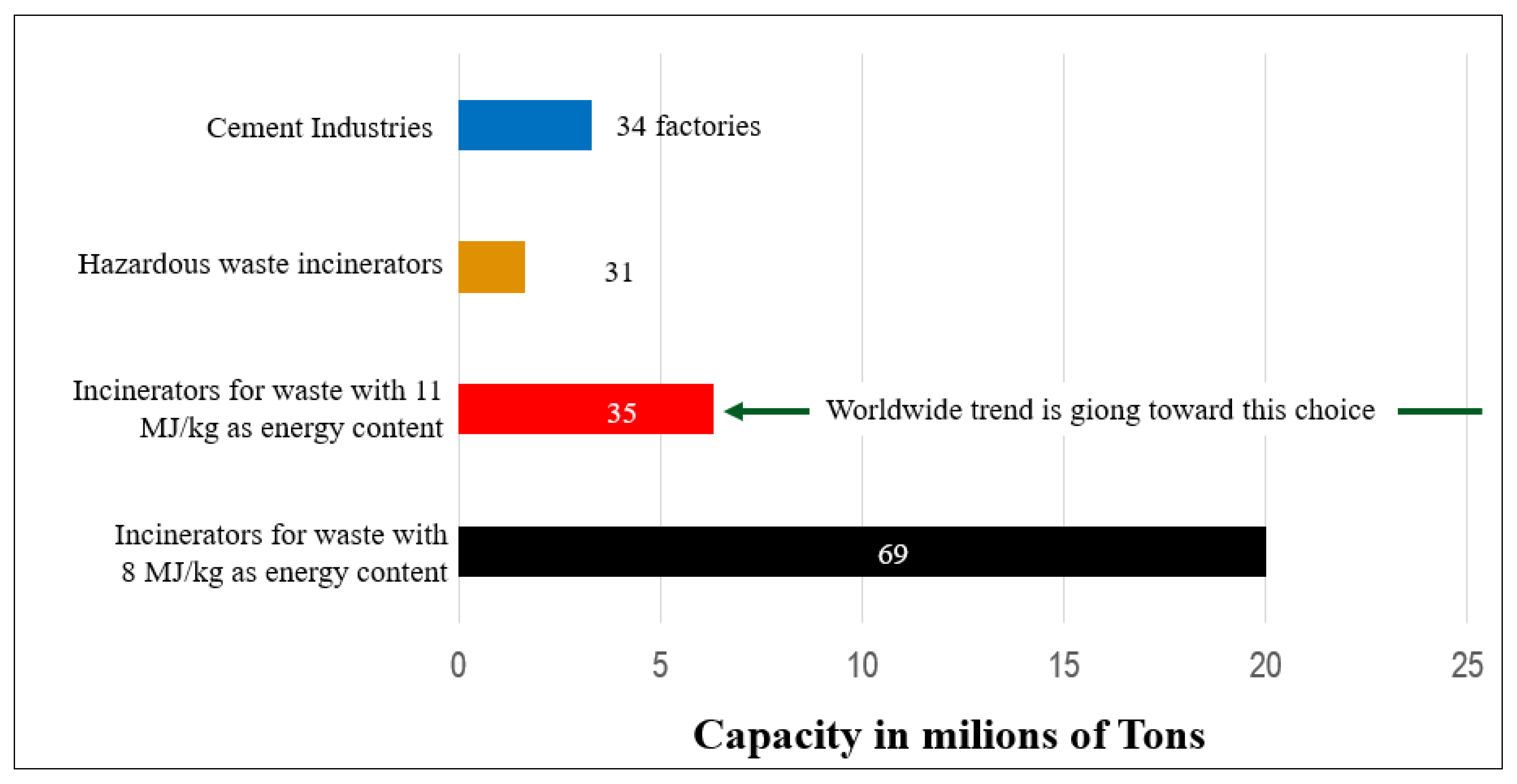
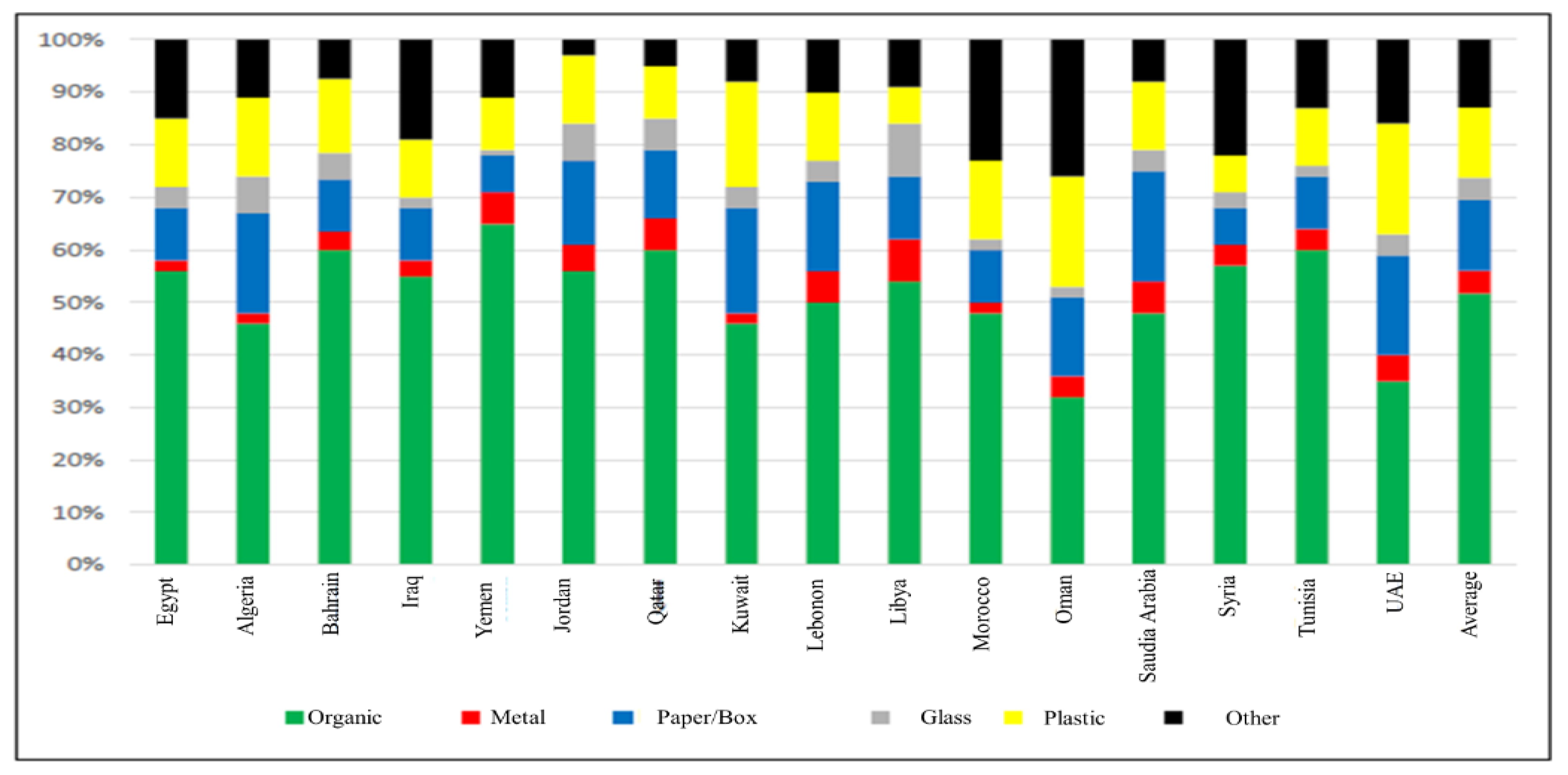

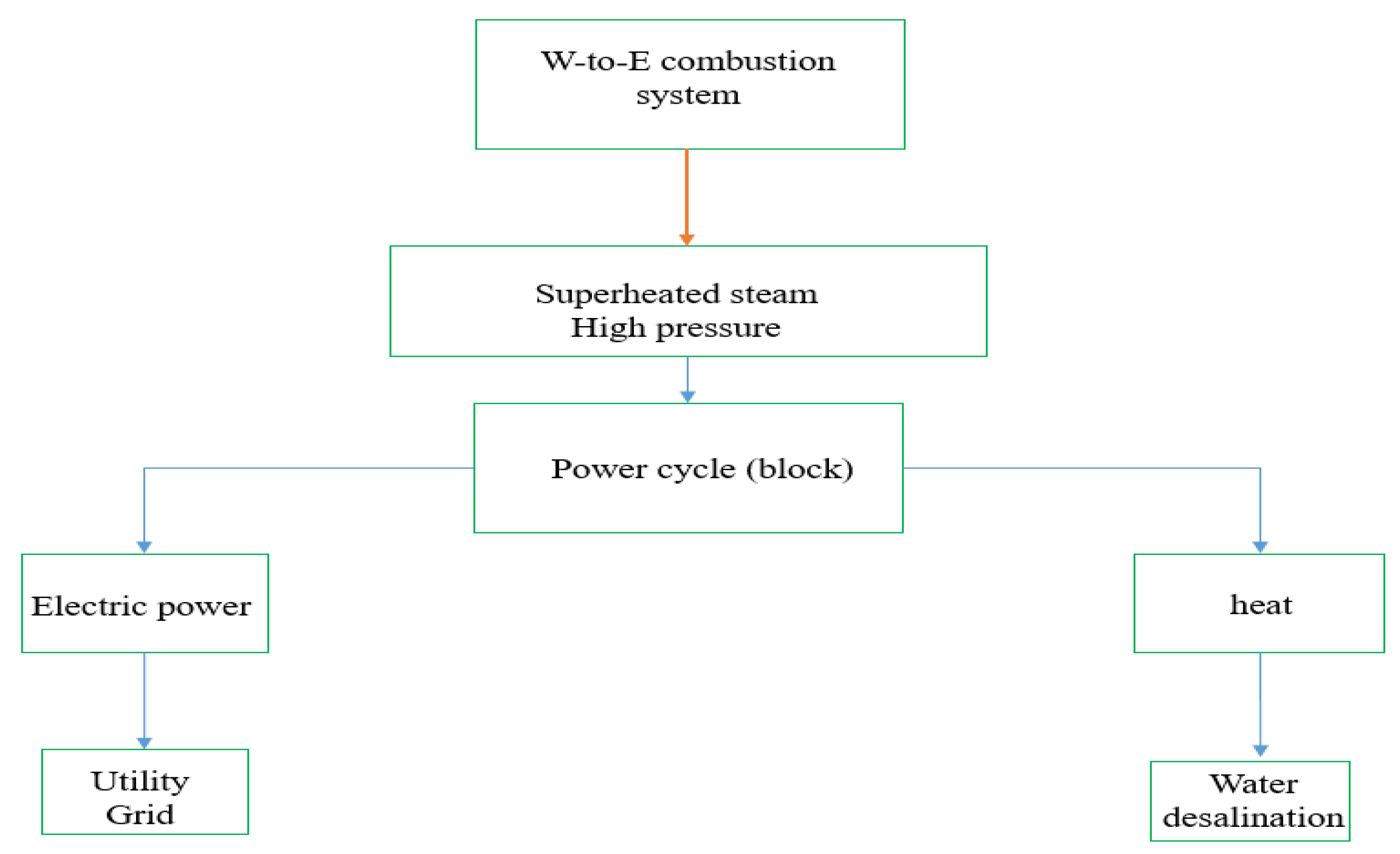
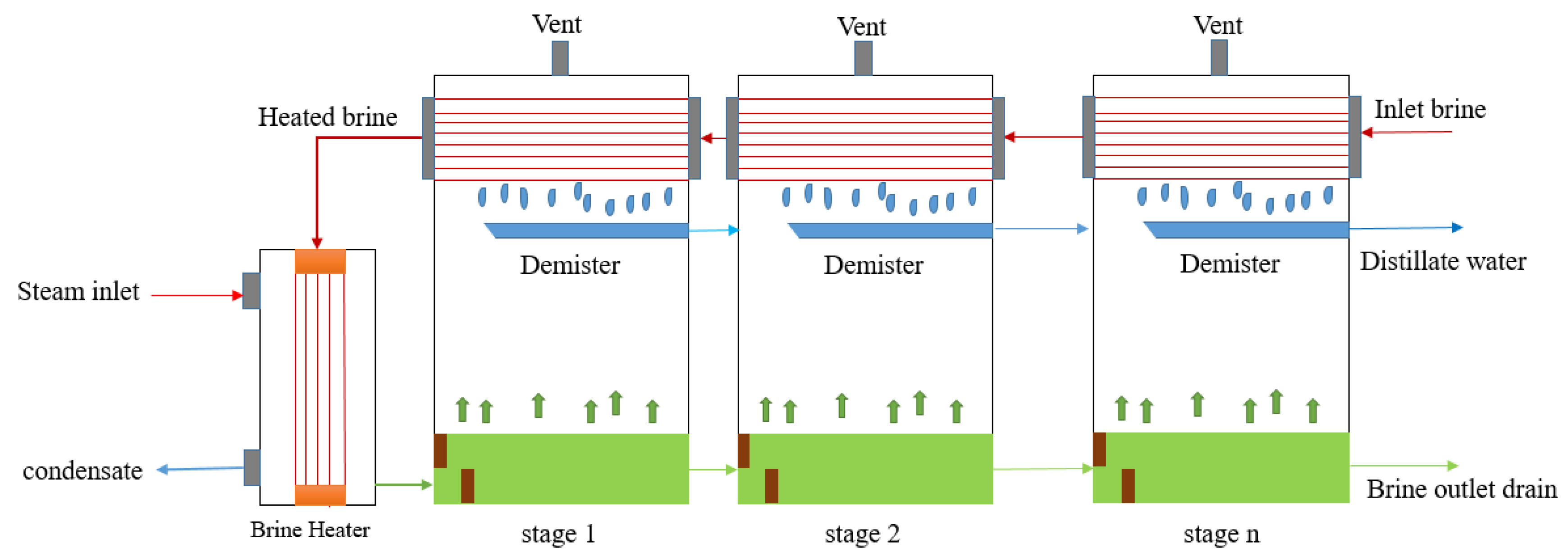

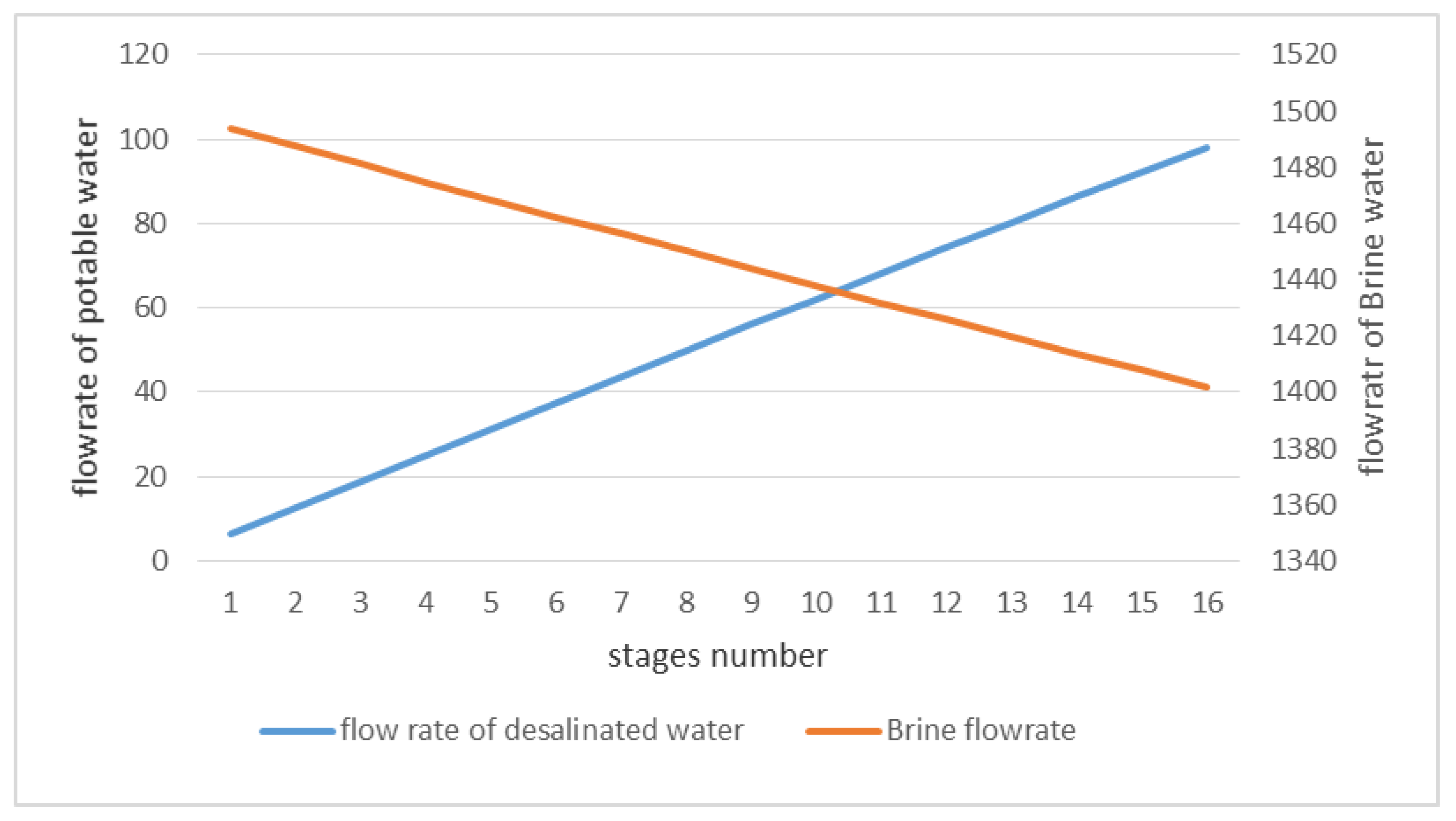
 Water,
Water,  Steam,
Steam,  Heat transfer fluid (Vp-1),
Heat transfer fluid (Vp-1),  Water desalination.
Water desalination.
 Water,
Water,  Steam,
Steam,  Heat transfer fluid (Vp-1),
Heat transfer fluid (Vp-1),  Water desalination.
Water desalination.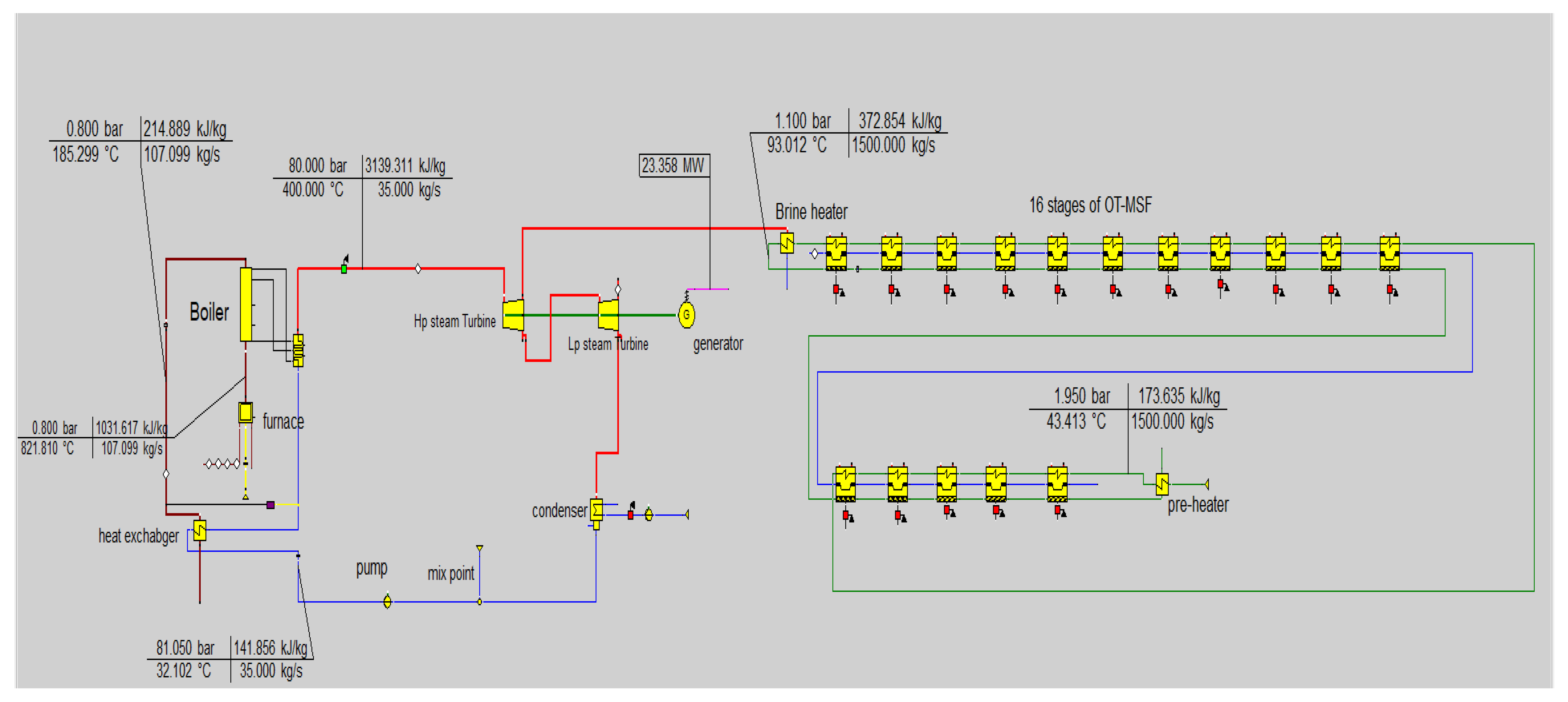
 OPEX (20% salary, 40% emissions treatment, 23% maintenance, 15% ash disposal, 2% other). OPEX: Operation Expenses.
OPEX (20% salary, 40% emissions treatment, 23% maintenance, 15% ash disposal, 2% other). OPEX: Operation Expenses.
 OPEX (20% salary, 40% emissions treatment, 23% maintenance, 15% ash disposal, 2% other). OPEX: Operation Expenses.
OPEX (20% salary, 40% emissions treatment, 23% maintenance, 15% ash disposal, 2% other). OPEX: Operation Expenses.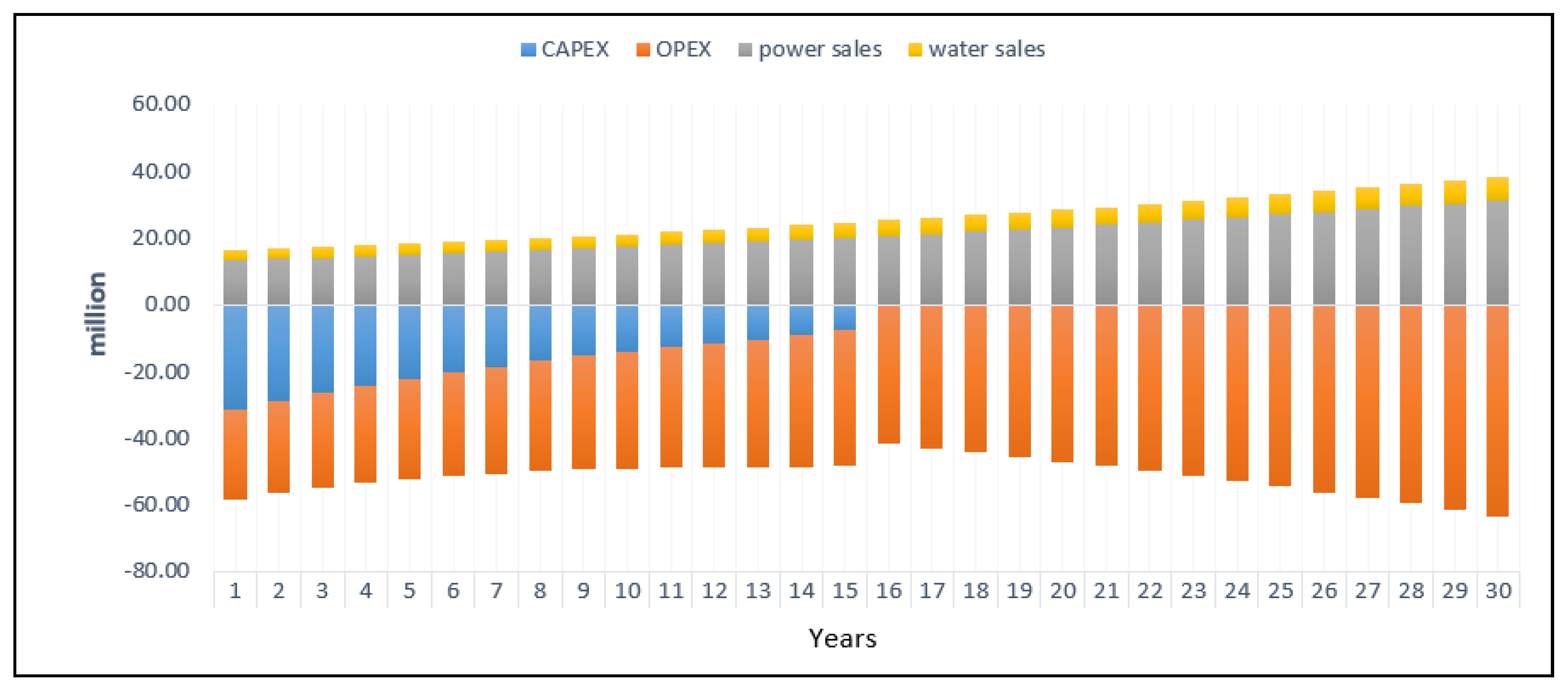
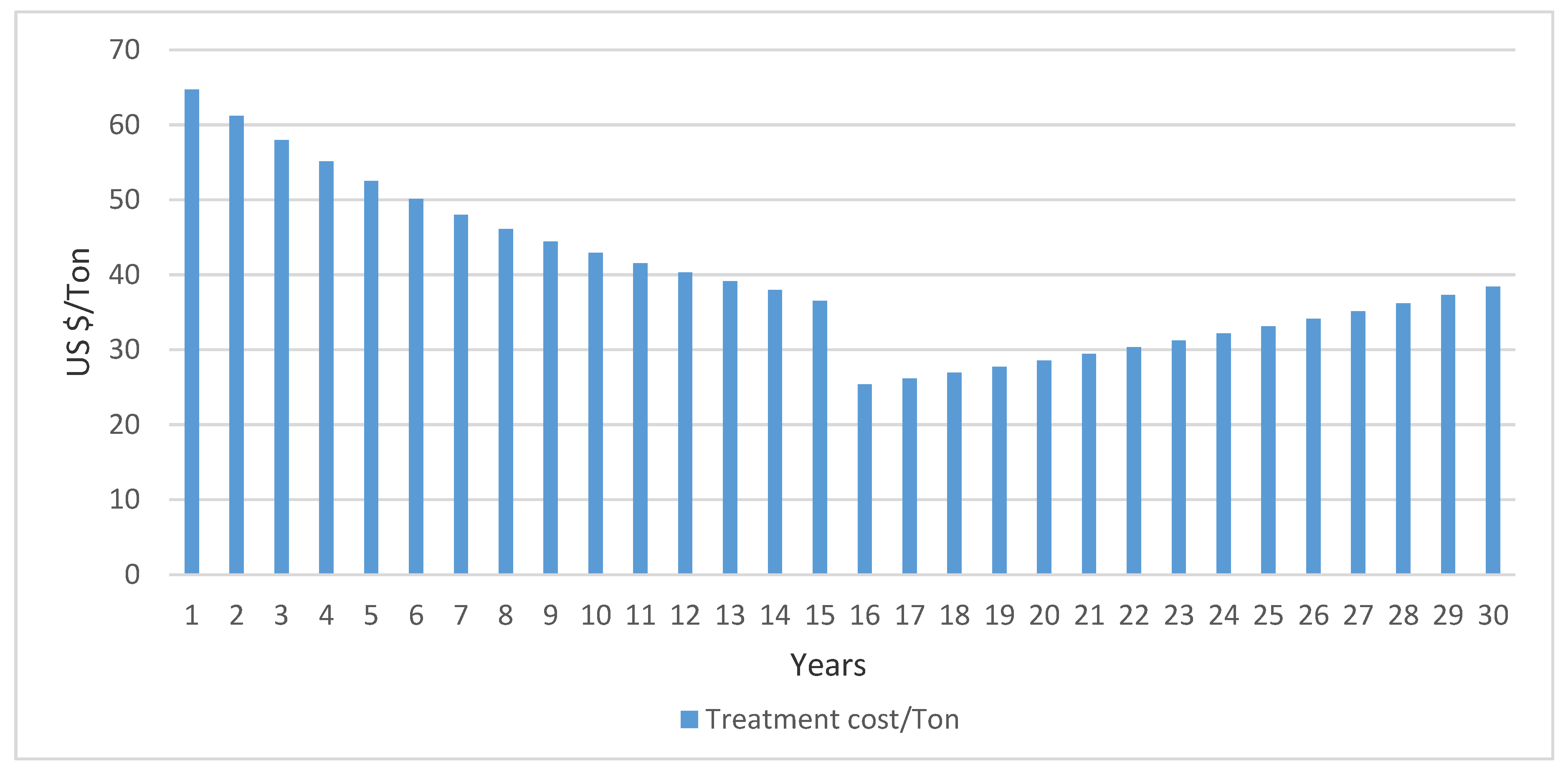
| Fraction | Percentage (%) | Fraction | Percentage (%) |
|---|---|---|---|
| Organic | 50–60 | Metals | 2–4 |
| Plastics | 10–15 | Glass | 2–4 |
| Paper/cardboard | 10–14 | Wood and garden waste | 1–2 |
| Other (e.g., hygiene products) | 5–10 | Textiles | 1–2 |
| Parameter | Symbol | Unit | Value |
|---|---|---|---|
| Water content | W | % | 60 |
| Total solids content | TS | % | 40 |
| Fuel ash | A | % of TS | 15 |
| Carbon | C | % of TS | 46.0 |
| Hydrogen | H2 | % of TS | 6.5 |
| Oxygen | O2 | % of TS | 45.85 |
| Nitrogen | N2 | % of TS | 0.9 |
| Sulfur | S | % of TS | 0.2 |
| Chlorine | Cl | % of TS | 0.55 |
| Component | Parameter | Value |
|---|---|---|
| Steam turbine | Isentropic efficiency | 85% |
| Generator | Generator efficiency | 85% |
| Condenser | Steam pressure | 0.1 bar |
| Pump | Isentropic efficiency | 80% |
| Pre-heater | Effectiveness | 70% |
| Parameter | Symbol | Value | Unit |
|---|---|---|---|
| Capacity | QMSW | 650,000 | ton/year |
| Working hours | h | 7200 | h/year |
| Lower calorific value | LCV | 7 | MJ/kg |
| Live flue gas temperature | - | 830 | °C |
| Exhausted flue gas temperature | - | 150–223 | °C |
| Live steam temperature (Hp turbine) | - | 400 | °C |
| Live steam pressure (Hp turbine) | - | 80 | bar |
| Live steam temperature (Lp turbine) | - | 120 | °C |
| Live steam pressure (Lp turbine) | - | 2 | bar |
| Exhausted steam temperature (Lp turbine) | - | 45 | °C |
| Incineration process efficiency | η | 0.8 | - |
| Plant Name and Location | Operation Year | Size (MLD) | Capital Cost (US$/MLD) | O&M Cost (US$/MLD) |
|---|---|---|---|---|
| Tobruk (extension), Libya | 2014 | 13.3 | 1.90 | 0.08 |
| Rabigh, KSA | 2005 | 25.0 | 2.34 | 0.09 |
| Abutaraba, Libya | 2007 | 40.0 | 1.75 | 0.07 |
| Zuara, Libya | 2010 | 40.0 | 1.49 | 0.06 |
| Layyah, United Arab Emirates | 2007 | 47.5 | 1.45 | 0.05 |
| Ras Al Khaimah, United Arab Emirates | 2005 | 68.2 | 1.46 | 0.05 |
| Sussa Derna Zawia, Libya | 2009 | 160.0 | 1.34 | 0.05 |
| Al Hidd, Bahrain | 2008 | 272.0 | 1.18 | 0.03 |
| Ras Laffan, Qatar | 2010 | 286.4 | 1.28 | 0.04 |
| Marafiq Jubail, KSA | 2009 | 800.0 | 1.39 | 0.06 |
| Parameter | Unit | Symbol | Value | Reference of Values |
|---|---|---|---|---|
| Feed water flow rate | Kg/s | Mf | 1500 | Assumed |
| Salt concentration | mg/L | Xi | 42,000 | Literature |
| Feed seawater temperature | °C | Tf | 48 | Calibrated |
| Steam temperature | °C | Ts | 120 | Calibrated |
| Top brine temperature | °C | T0 | 93 | Calibrated |
| Brine temperature in the last (16th) stage | °C | Tn | 55 | Calibrated |
| Parameter | Unit | Symbol | Value | Reference of Values |
|---|---|---|---|---|
| Inflation rate | % | f | 3 | Assumed |
| Interest rate | % | ri | 6 | Assumed |
| Discount rate | % | rd | 5 | Assumed |
| Cost of power sale | US$ | - | 0.08 | Assumed |
| Cost of water sale | US$ | - | 1.2 | Literature |
| Lifetime of the power plant | years | n | 30 | Literature |
| Operational hours of the power plant | h/year | h | 7200 | Literature |
© 2020 by the authors. Licensee MDPI, Basel, Switzerland. This article is an open access article distributed under the terms and conditions of the Creative Commons Attribution (CC BY) license (http://creativecommons.org/licenses/by/4.0/).
Share and Cite
Thabit, Q.; Nassour, A.; Nelles, M. Potentiality of Waste-to-Energy Sector Coupling in the MENA Region: Jordan as a Case Study. Energies 2020, 13, 2786. https://doi.org/10.3390/en13112786
Thabit Q, Nassour A, Nelles M. Potentiality of Waste-to-Energy Sector Coupling in the MENA Region: Jordan as a Case Study. Energies. 2020; 13(11):2786. https://doi.org/10.3390/en13112786
Chicago/Turabian StyleThabit, Qahtan, Abdallah Nassour, and Michael Nelles. 2020. "Potentiality of Waste-to-Energy Sector Coupling in the MENA Region: Jordan as a Case Study" Energies 13, no. 11: 2786. https://doi.org/10.3390/en13112786
APA StyleThabit, Q., Nassour, A., & Nelles, M. (2020). Potentiality of Waste-to-Energy Sector Coupling in the MENA Region: Jordan as a Case Study. Energies, 13(11), 2786. https://doi.org/10.3390/en13112786





